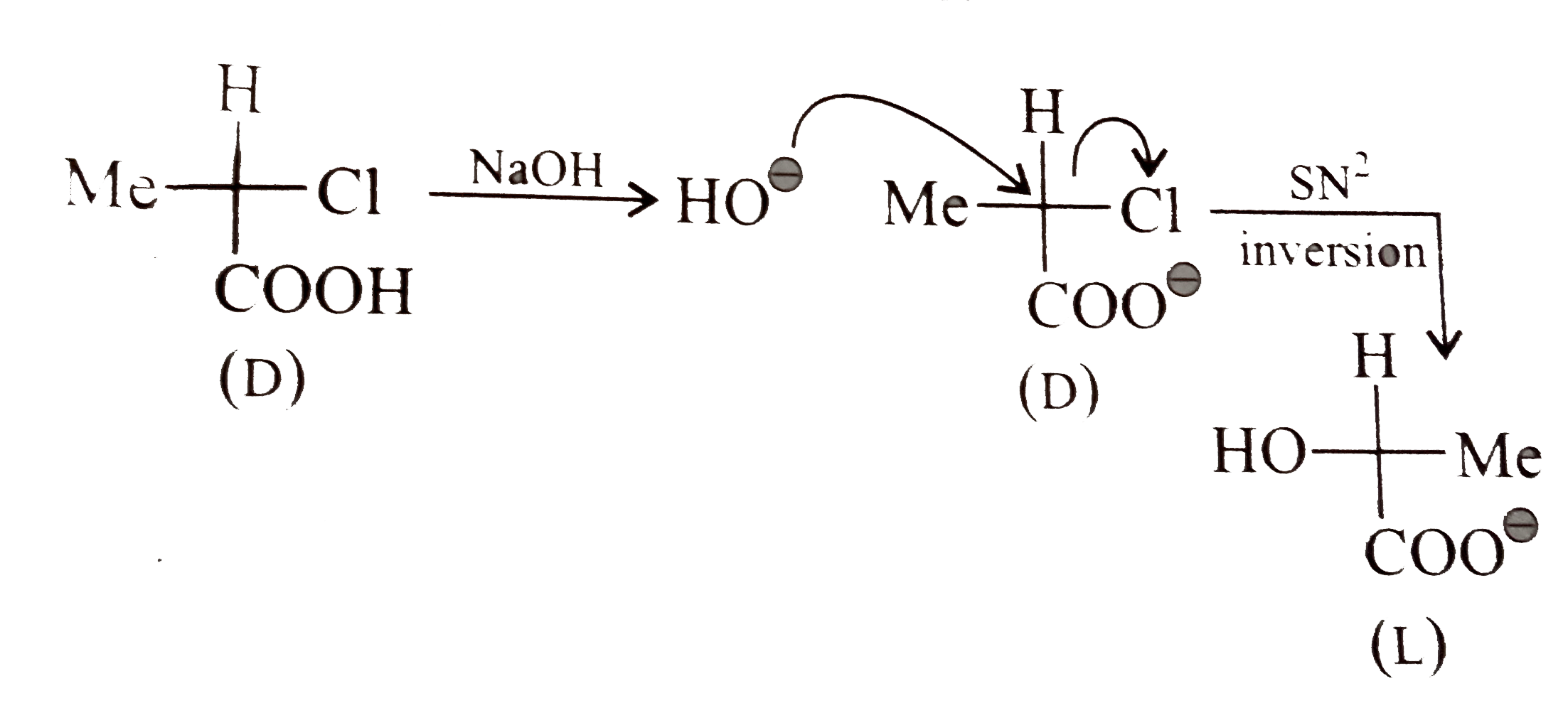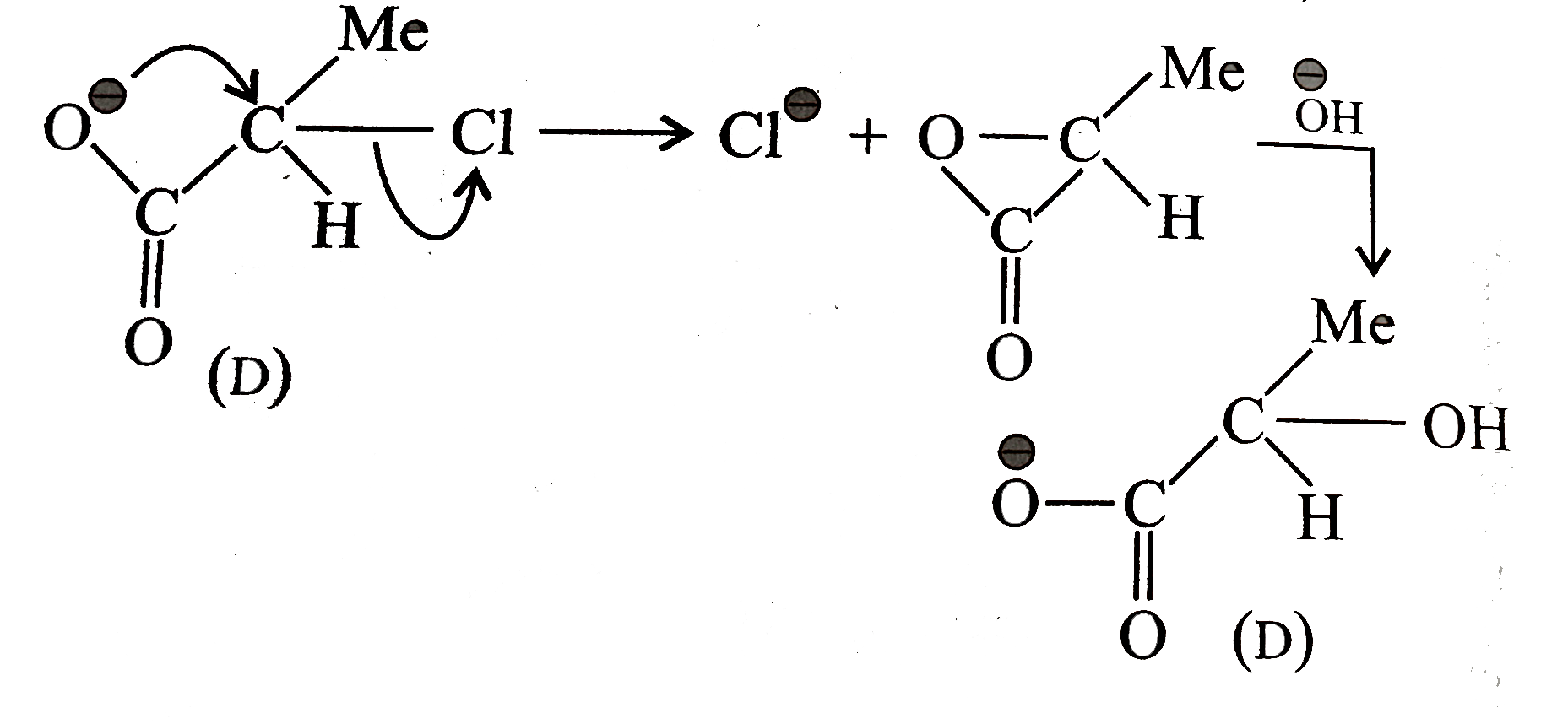Complete the following and state the relations between configurations of the reactant and products.
(i) .D−MeCH(OH)Et+Ac2O→ ?
(ii) .D−MeCH(Cl)COOH+2NaOH→ ?
If no bond to the asymmetric C atom is broken, no inversion takes place. If it breaks then for SN2 reaction inversion takes place , and for SN1, retention and racemisation take place.

(ii) Depending on the conditions, it can be SN2 or SN1, If the concentration of base is high. SN2 mechanism occurs and hence inversion takes place.

If the case is dilute, SN1 mechanism occurs, therefore, retention and racemisation are expected , but neighbouring group participation of (COOӨ) operates.

Due to the 'protection', the ӨOH ion attracks from the same side and hence retention occurs.
Topper's Solved these Questions
- ORGANIC REACTION MECHANISMBOOK - CENGAGE CHEMISTRY ENGLISHCHAPTER - ORGANIC REACTION MECHANISMEXERCISE - Subjective
19 Videos
- ORGANIC REACTION MECHANISMBOOK - CENGAGE CHEMISTRY ENGLISHCHAPTER - ORGANIC REACTION MECHANISMEXERCISE - Comprehension
35 Videos
- ORGANIC REACTION MECHANISMBOOK - CENGAGE CHEMISTRY ENGLISHCHAPTER - ORGANIC REACTION MECHANISMEXERCISE - Analytical and Descriptive
6 Videos
- NCERT BASED EXERCISEBOOK - CENGAGE CHEMISTRY ENGLISHCHAPTER - NCERT BASED EXERCISEEXERCISE - Chemical Equilibrium
73 Videos
- P-BLOCK GROUP 13 - BORON FAMILYBOOK - CENGAGE CHEMISTRY ENGLISHCHAPTER - P-BLOCK GROUP 13 - BORON FAMILYEXERCISE - Exercise Archives (Subjecive)
9 Videos
Similar Questions
Complete the following and state the relations between configurations of the reactant and products.
(i) .L−MeCH(OH)Et+HBr→ ?
(ii) .L−MeEtPrCOMe+HI→ ?
View SolutionComplete the following reactions :
(CH2COOH)2+NaOH→
View SolutionComplete the following reactions :
2CH3COOHP2O5−−→
View SolutionComplete the following reaction ,
(COOH)2+H2SO4→
View SolutionComplete the following chemical equations :
(i) NaOH+Cl2→(hot and conc.)
(ii) XeF4+O2F2→
View SolutionFor each of the following reactions, express the given rate of change of concentration of the reactants or Products in that reaction:
a.H2O2+2H⊕+3lɵ→Iɵ3+2H2O, −d[Iɵ]dt=?, −d[H⊕]dt?
(b) 16H⊕+2Mnɵ4+101ɵ→2Mn2++8H2O+5I2, −d[MNOɵ4]dt=?
( c) 4NH3+5O2→4NO2+6H2O , −d[NH3]dt=?
View SolutionComplete the following reactions:
(A)Glyoxal1.NaOH−−−−−→2.H3O⊕(B)
View SolutionComplete the following reactions :
CH3COOH+C2H5OHconc.−−−→H2SO4
View SolutionComplete the following chemical reaction equations :
(i) NaOH(cold and dilute)+Cl2→
(ii)XeF6(excess)+H2O→
View SolutionComplete the following reactions
(i) O2−2+H2O→ (ii) O−2+H2O→
View Solution
